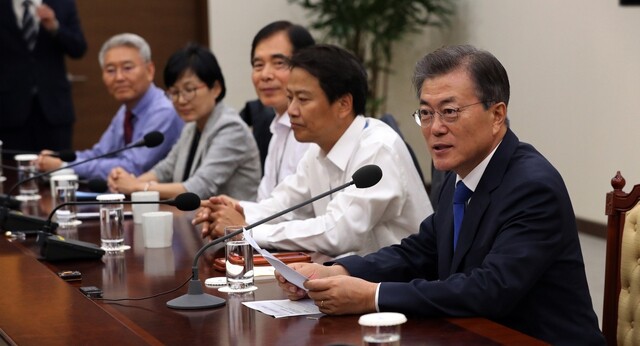hankyoreh
Links to other country sites 다른 나라 사이트 링크
President Moon reiterates “KOR-US alliance designed to keep peace”

There are indications that relief could be coming to the tensions around the Korean Peninsula, which have escalated due to North Korea’s ICBM test launches and the “war of words” between Pyongyang and Washington. On Aug. 14, South Korean President Moon Jae-in emphatically told his American allies that “the North Korean nuclear issue must be resolved peacefully.” When Joseph Dunford, Chairman of the US Joint Chiefs of Staff, paid a visit to Moon on the same day, he spoke of the danger of war and called for a diplomatic solution.
During a meeting with his advisors and senior secretaries on Aug. 14, Moon urged North Korea to “immediately halt its provocations and threatening words and behavior” and to “stop making the situation worse.” In remarks aimed at the US, Moon said that “the North Korean nuclear issue must be resolved peacefully, no matter how complicated that process may be.” On this point, Moon said, South Korea and the US are on the same page.
“The South Korea-US alliance is designed to keep the peace. I’m confident that the US will respond to the current situation in a rational and responsible manner, and with the same approach as us,” Moon went on to say. These were the first remarks that Moon had made at an official event since US President Donald Trump’s remarks about “fire and fury” and North Korea’s threat to launch an “enveloping strike” near North Korea.

“Peace is in South Korea’s national interest. There must not be another war on the Korean Peninsula,” Moon reiterated. “Peace on the Korean Peninsula will not come through force. Peace and negotiations may be painful and protracted, but that is what we must do.”
The president followed up by pledging “to the Korean people, I make this categorical promise: we are effectively managing the crisis, and we are taking thorough precautions for any contingencies. I will ensure that the Korean Peninsula is a place of peace and prosperity for the Korean people.”
Dunford, who began his tour of Asia with a visit to South Korea, also emphasized the need to resolve the North Korean nuclear issue through diplomatic and peaceful means. While visiting Moon at the Blue House on the afternoon of Aug. 14, Dunford explained that the primary purpose of the US military is to support the US government’s efforts to put diplomatic and economic pressure [on North Korea], and that it is preparing military options in the event that such efforts fail. Dunford also said that the US would be in close consultation with South Korea on an alliance level with regard to responding and taking action. Everyone expected that the current situation would be resolved without war, he added.
During a subsequent press conference held at ROK-US Combined Forces Command, Dunford said that the important message was that the US was seeking a peaceful solution and emphasized that there was no impending crisis on the Korean Peninsula. He also said there had been no talks or discussion of a pre-emptive war, while adding that no one could predict what might occur if diplomatic and economic methods failed. While speaking with reporters on his flight to South Korea on Aug. 13, Dunford said that “no one is more reluctant to going to war,” than the United States, since they are the ones who would have to make the actual sacrifices.
By Kim Bo-hyup, Blue House correspondent and Park Byong-su, senior staff writer,
Please direct questions or comments to [english@hani.co.kr]

Editorial・opinion
![[Column] Season 2 of special prosecutor probe may be coming to Korea soon [Column] Season 2 of special prosecutor probe may be coming to Korea soon](https://flexible.img.hani.co.kr/flexible/normal/500/300/imgdb/original/2024/0426/3317141030699447.jpg) [Column] Season 2 of special prosecutor probe may be coming to Korea soon
[Column] Season 2 of special prosecutor probe may be coming to Korea soon![[Column] Park Geun-hye déjà vu in Yoon Suk-yeol [Column] Park Geun-hye déjà vu in Yoon Suk-yeol](https://flexible.img.hani.co.kr/flexible/normal/500/300/imgdb/original/2024/0424/651713945113788.jpg) [Column] Park Geun-hye déjà vu in Yoon Suk-yeol
[Column] Park Geun-hye déjà vu in Yoon Suk-yeol- [Editorial] New weight of N. Korea’s nuclear threats makes dialogue all the more urgent
- [Guest essay] The real reason Korea’s new right wants to dub Rhee a founding father
- [Column] ‘Choson’: Is it time we start referring to N. Korea in its own terms?
- [Editorial] Japan’s rewriting of history with Korea has gone too far
- [Column] The president’s questionable capacity for dialogue
- [Column] Are chaebol firms just pizza pies for families to divvy up as they please?
- [Column] Has Korea, too, crossed the Rubicon on China?
- [Correspondent’s column] In Japan’s alliance with US, echoes of its past alliances with UK
Most viewed articles
- 1‘We must say no’: Seoul defense chief on Korean, USFK involvement in hypothetical Taiwan crisis
- 2Is Japan about to snatch control of Line messenger from Korea’s Naver?
- 3No good, very bad game for Korea puts it out of Olympics for first time since 1988
- 4Samsung subcontractor worker commits suicide from work stress
- 5[Editorial] Korea’s surprise Q1 growth requires objective assessment, not blind fanfare
- 6Division commander ordered troops to enter raging flood waters before Marine died, survivor says
- 7N. Korean delegation’s trip to Iran shows how Pyongyang is leveraging ties with Moscow
- 8Korea’s 1.3% growth in Q1 signals ‘textbook’ return to growth, says government
- 9Flying “new right” flag, Korea’s Yoon Suk-yeol charges toward ideological rule
- 10[Column] Park Geun-hye déjà vu in Yoon Suk-yeol